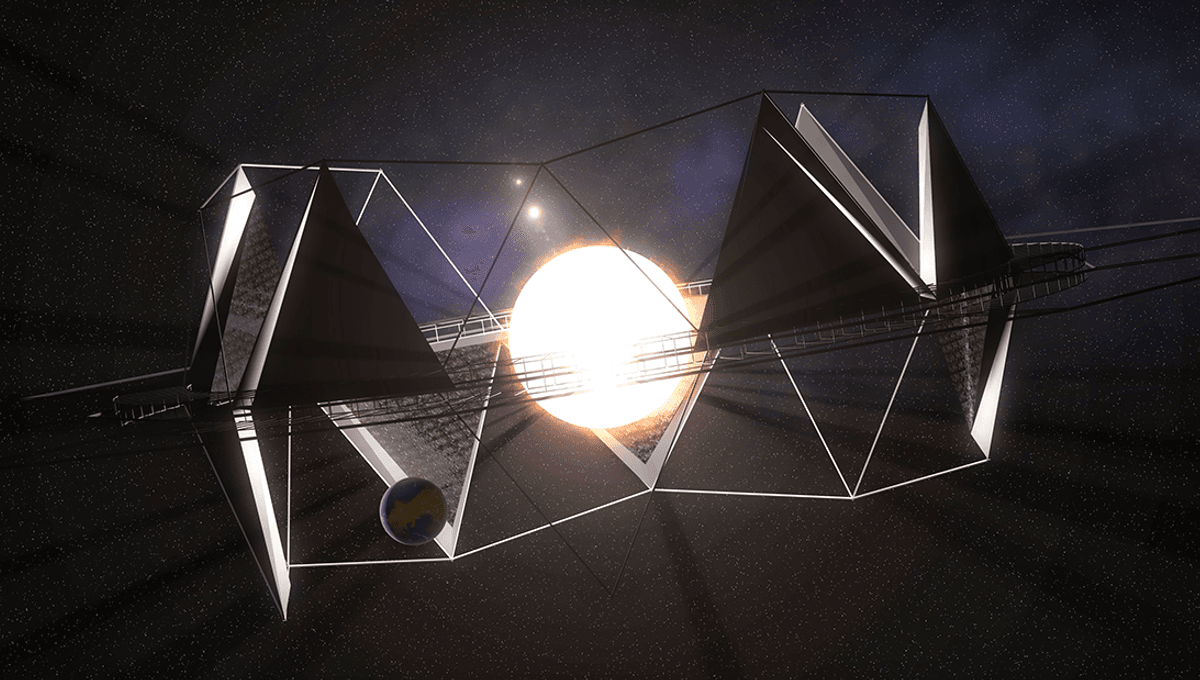
Say humanity one day needed to move our star. Maybe an alien berserker is headed our way and would arrive in a few tens of thousand of years, or we discovered we were about to head through a region of dark matter in our galaxy that would wreak havoc on our Solar System. Perhaps we just discover that another region of space is more interesting, and move to join the party. Take your sci-fi pick. The question is, would we be able to move ourselves out of the way, and take our beloved Sun with us?
It’s not exactly a pressing question, but it is one that physicists have put a little thought into. Moving a star is a colossal task. The Sun’s mass is around 1.989 x 1030 kilograms, or 333,000 times the mass of the Earth. Considering that it’s an effort to get enough thrust to take spaceships out of our atmosphere, it’s not a task we are up to yet. It may be well beyond a Type I civilization, but not a Type II civilization on the Kardashev scale.
And if we do decide to move our star, we’re still going to let the star do most of the work. One idea, named the Shkadov Thruster after Russian physicist Leonid Shkadov who proposed it, is actually a lot simpler than you’d expect moving our Solar System to be. The basic idea is to take a giant, concave mirror and place it facing the Sun. The mirror would be placed in a point in space where solar radiation pressure on the mirror balances out with gravity, so that it will remain in position, reflecting radiation back at the Sun. This part will not be easy.
“As the mirrors are not oriented spherically those whose normal incidence makes an angle with respect to the Sun will experience a net torque from the solar radiation pressure gradient, causing them oscillate. Any damping force is likely to return them to a stable equilibrium where they are aligned radially, thus reflecting light back at the Sun,” a 2019 paper on the topic explains. “Such a stabilization system along with any struts supporting the mirror foil will require thinner foil in order to budget mass for these systems, thus resulting in great transmittance of sunlight. Nevertheless, stabilizers are necessary if the mirrors are to remain parabolic on astronomical times.”
With the mirror in place and reflecting light, this increases the temperature of the photosphere and produces a teeny tiny amount of thrust.
Using this method, we are not getting anywhere very fast. The distance you can cover depends on where you want to go, and whether you are fighting our orbit around the Milky Way or merely accelerating our passage through it. But roughly speaking, one study found that during one orbit of the galaxy you could alter the Sun’s position by around 40 parsecs (130 light-years). Say we wanted to swap our star for another one (like cosmological Pogs) – using this method we could reach some of the closer stars.
Another idea is to use “active thrusters” rather than the passive thrust generated by Shkadov-inspired megastructures. In one idea, termed the Caplan Thruster, a Dyson Sphere collects solar wind and directs it to the engine, which uses nuclear fusion to create jets.
“Exhaust from the engine be may collimated with magnetic fields into two oppositely directed jets, one aimed toward the Sun and one away from the Sun,” the 2019 paper explains. “The jet aimed away from the Sun imparts a net momentum to the Solar System, while the jet aimed toward the Sun prevents the engine from colliding with the Sun. This engine is effectively a tugboat which pushes the Sun.”
Though the thruster could operate for 100 million years, this team – commissioned by YouTuber Kurzgesagt – believes that 10 million years would be sufficient to push our star out of the way of, say, a supernova. Using more of the mass of a Sun-like star, they suggest it may be possible to achieve escape velocity from our galaxy, and travel to another.
Though this all sounds feasible (to a much more advanced civilization than our own) it does sort of beg the question: why have we not seen any signs of other civilizations (with access to the same physics) doing this? Where is everybody?
Source Link: How Physicists Think Humanity Could Move Our Entire Solar System